Your bread baking times in a solar oven will vary based on several key factors. In a basic box solar oven, expect 45 minutes for buttermilk bread at 330°F, while parabolic ovens can match conventional oven times. You'll need 1-2 hours for quick breads on partly cloudy days, and up to 2 hours for yeast breads in ideal conditions. Dark pans speed up cooking by 15-20 minutes compared to glass ones. Position your oven between 11 am and 3 pm for fastest results, and rotate every 30-45 minutes. Winter baking requires longer times, often doubling summer durations. Understanding these timing principles will transform your solar baking success.
Basic Box Solar Oven Times
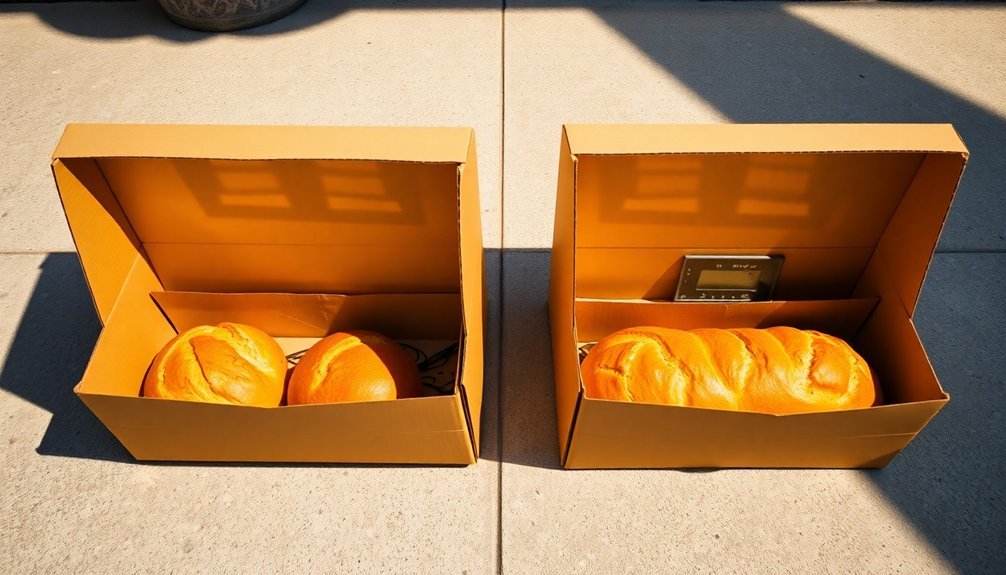
You'll achieve the best results by using dark-colored pans and ensuring your oven has proper insulation.
The oven's efficiency relies on full, direct sunlight and effective heat retention through features like a black heat sink and a clear plastic window.
If you're baking on cloudy days, you'll need to extend your cooking times considerably, as reduced sunlight directly impacts the oven's performance.
Most recipes like buttermilk bread require 45 minutes at 330°F when using a solar oven.
Parabolic Solar Oven Performance
With their advanced reflective dish design, parabolic solar ovens offer remarkably fast bread baking times and superior performance compared to basic box ovens. You'll find these cookers can reach temperatures up to 290°C (550°F), allowing you to bake bread in times comparable to conventional ovens.
The efficiency of your parabolic solar oven will depend on its design and materials. Top-performing models can achieve over 90% solar energy efficiency, while standard versions typically operate between 26-38% efficiency. You'll get the best results by positioning your oven to track the sun's movement both north-south and east-west. The three metal layers in the internal tube face, consisting of aluminum nitride, stainless steel, and copper, ensure optimal heat absorption and distribution.
| Bread Type | Baking Time | Required Temperature |
|---|---|---|
| Basic Loaf | 30-45 min | 200°C (392°F) |
| Flatbread | 15-20 min | 230°C (446°F) |
| Rolls | 20-25 min | 210°C (410°F) |
Your parabolic oven's compound parabolic concentrators (CPCs) will focus sunlight effectively even in less-than-ideal conditions, including cloudy or windy days. You won't need to adjust cooking times considerably unless there's heavy cloud cover, and you'll find the consistent heat distribution results in evenly baked bread with excellent crust formation.
Weather Impact On Baking Duration
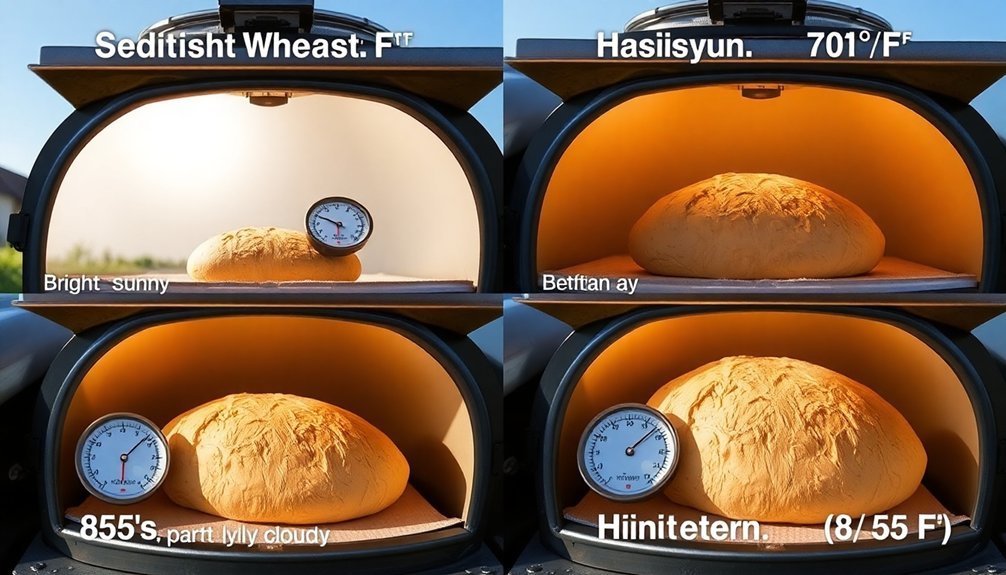
While parabolic solar ovens offer impressive performance capabilities, weather conditions directly influence their baking times and effectiveness.
You'll need to take into account cloud cover as your primary concern, as it greatly impacts the oven's temperature and efficiency. Even partial clouds can create inconsistent heating, affecting your bread's rise and structure.
Wind poses another vital challenge you'll need to address. It can quickly rob your solar oven of heat, so you should choose a wind-protected location and guarantee proper insulation. Properly insulated ovens can maintain warmth for hours after sunset.
You'll want to position your oven strategically to minimize wind exposure while maintaining ideal sun alignment.
The season and time of day will determine your baking success. You'll get the best results during summer months between 11:00 am and 3:00 pm, when the sun is strongest.
In winter, you'll need to adjust your oven's angle more frequently and expect longer cooking times. For best performance, aim to bake when ambient temperatures are around 25°C (77°F).
If you're in a southern location closer to the Equator, you'll benefit from shorter baking times due to more direct sunlight exposure.
Pan Selection And Cooking Speed
Your choice of baking container greatly affects how quickly your bread will bake in a solar oven, with dark-colored pans and glass dishes heating up faster than light-colored alternatives.
When selecting between metal and glass containers, you'll find that dark glass dishes are particularly effective for achieving an even crust, while black metal pans excel at heat absorption and retention.
The type of lid you use matters greatly too – tight-fitting lids help maintain consistent temperatures and prevent moisture loss, making your solar bread baking more efficient.
Dark Pans Heat Faster
Cookware selection plays a critical role in solar oven baking times, with dark pans emerging as the clear winner for effectiveness.
You'll find that dark metal pans absorb sunlight and convert it to heat more effectively than their lighter counterparts, which tend to reflect sunlight away. This superior heat absorption means you'll achieve faster baking times for your bread.
When you're choosing cookware for your solar oven, opt for dark-colored options like Granite Ware or cast iron pots.
While cast iron heats more slowly, it maintains temperature consistently once hot. You'll want to avoid shiny or light-colored pans unless you can cover them with a dark material to improve their heat absorption capability.
To maximize your baking efficiency, you'll need to pre-heat your solar oven for 15-20 minutes before adding your bread dough.
Remember that you might need to adjust traditional baking times, as dark pans heat up more quickly.
Position your oven facing south for ideal sun exposure, and monitor the internal temperature regularly.
For best results, use smaller containers to guarantee even baking throughout your bread.
Metal Vs Glass Containers
The choice between metal and glass containers in your solar oven can make or break the success of your bread baking. Metal pans, especially aluminum ones, conduct heat more efficiently and promote even cooking, while glass containers can slow down the baking process and may result in underbaked centers.
When you're baking bread in a solar oven, metal containers offer distinct advantages. They'll help your bread rise more evenly and reduce overall baking time, which is vital when you're relying on sunlight.
Glass pans, while common in conventional ovens, can extend your baking time by 5-15 minutes and may create moisture retention issues that affect your bread's texture.
Here's what you'll need to take into account when selecting your container:
- Baking duration: Metal pans typically complete bread baking in 1-2 hours, while glass requires longer.
- Temperature management: Metal maintains more consistent temperatures throughout the baking process.
- Moisture control: Glass can create unwanted condensation, potentially affecting your bread's crust.
- Heat distribution: Metal provides more even cooking, reducing the risk of doughy centers.
For best results in solar bread baking, you'll want to choose metal containers and adjust your recipe's timing accordingly.
Lid Types Matter Most
Beyond container material choices, lid selection plays a central role in determining how quickly your bread will bake in a solar oven.
You'll want to confirm your lid creates an effective seal to maintain consistent temperatures, as wind protection is vital for ideal baking times. When selecting a lid, opt for dark-colored or black options that match your cookware's heat absorption properties.
Heavy-duty lids contribute to better heat retention throughout the baking process, which is fundamental since you'll need to regularly adjust your solar oven to follow the sun's position.
If you're using glass lids, consider painting them black to enhance their heat absorption capability. The lid should fit your baking container perfectly, leaving no gaps that could let heat escape.
Remember that your lid choice affects the thermal mass of your cooking setup. While heavier lids, like those made of cast iron, take longer to heat initially, they'll help maintain steady temperatures once hot.
This is particularly important for bread baking, where temperature fluctuations can greatly impact your results. You'll also want to confirm your lid allows enough headroom for the bread to rise properly.
Temperature Zones And Timing
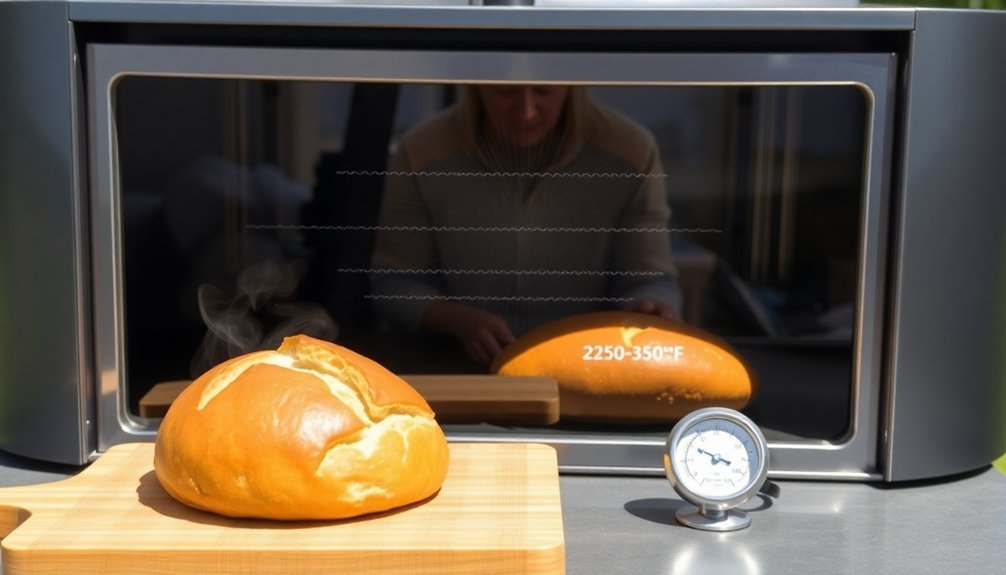
Successfully baking bread in a solar oven requires understanding three distinct temperature zones that affect cooking times and results.
In the high temperature zone (250°F-350°F), you'll find ideal conditions for baking on clear, sunny days. Quick breads take 45-60 minutes, while yeast breads need about 2 hours to reach the required internal temperature of 190°F.
The moderate zone (200°F-250°F) works on partially cloudy days, but you'll need to double your conventional baking times. Quick breads typically require 1-2 hours, and you'll want to adjust timing based on cloud coverage.
The lower zone (below 200°F) isn't suitable for bread baking, though it works well for slow-cooked dishes.
For successful solar bread baking, follow these essential timing guidelines:
- Preheat your solar oven before adding bread
- Reposition the oven every 30 minutes to maintain temperature
- Use dark-colored pans to reduce cooking time
- Bake during peak sun hours (11:00 am – 3:00 pm)
Remember that solar ovens won't brown bread like conventional ovens, but they'll still produce fully baked, delicious results when you follow proper timing guidelines.
Seasonal Baking Time Adjustments
Just as temperature zones affect daily baking times, seasonal changes present additional timing considerations for solar oven bread baking.
You'll need to adjust your baking schedule notably between summer and winter months, as temperatures can vary by up to 100°F (28°C).
In summer, you can expect your solar oven to reach 300-350°F (148-176°C), allowing for faster baking times and multiple batches per day.
Winter baking requires more patience, with temperatures rarely exceeding 300°F (148°C) and longer preheating times.
You'll also face more cloudy days during winter months, which can further extend baking times or halt baking altogether.
Your location plays a vital role in these seasonal adjustments.
If you're in a high-sun region, you'll experience less dramatic seasonal variations and more consistent baking times year-round.
However, in low-sun regions, you'll need to plan for notably longer baking times during winter months.
For best results, adapt your recipes to the season.
Quick breads are more forgiving and work well year-round, while yeast breads require more precise temperature control and may need additional rising time in cooler conditions.
Direct Sunlight Positioning Tips
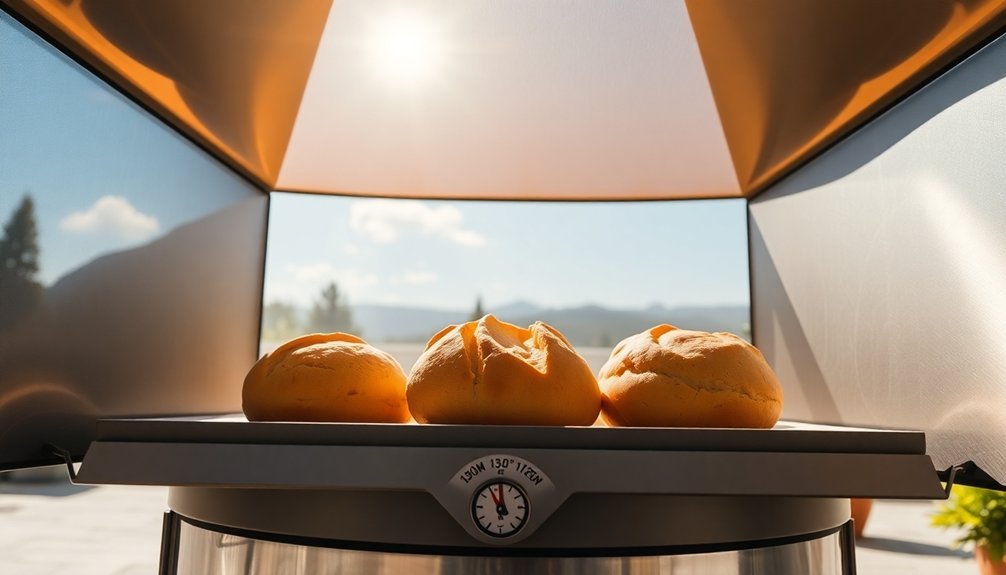
Proper positioning stands at the heart of successful solar bread baking. You'll want to place your solar oven in an area that receives consistent sunlight between 11 am and 3 pm, when the sun's intensity is at its peak.
To maintain ideal temperature for bread baking, you'll need to rotate your oven every 30-45 minutes, following the sun's path across the sky.
For the best bread baking results, follow these essential positioning steps:
- Tilt your oven's reflective surfaces to match the sun's angle, ensuring maximum heat collection through the glass top.
- Secure the oven's base with weights or anchors to prevent any unwanted movement that could disrupt the baking process.
- Keep all reflective surfaces spotlessly clean using a vinegar-water solution to maximize heat collection.
- Monitor your oven's temperature gauge closely and adjust positioning if the temperature drops below ideal bread-baking range.
Choose a location away from potential wind disruption, as strong gusts can greatly reduce your oven's temperature.
If you notice passing clouds, you may need to extend your bread's baking time to compensate for temporary temperature fluctuations. Remember to check that there aren't any nearby objects casting shadows on your oven.
Frequently Asked Questions
Can Bread Dough Rise Properly in a Solar Oven?
You shouldn't let your dough rise in a solar oven. Instead, let it rise in a warm, draft-free place first. Once it's doubled in size, you can transfer it to your preheated solar oven.
How Do Different Bread Recipes Affect Solar Oven Baking Times?
You'll find that simple yeast breads bake in about an hour, while complex recipes with nuts and fruits take up to 2.5 hours. Dense ingredients and larger loaves need more time in your solar oven.
What Happens if I Open the Solar Oven to Check Bread?
If you open your solar oven, you'll lose significant heat and disrupt the baking process. Your bread may not rise properly, cook unevenly, and take much longer to finish. It's best to minimize checking.
Does Altitude Affect Solar Oven Baking Times for Bread?
Yes, altitude will affect your solar bread baking times. You'll need longer baking periods due to lower atmospheric pressure and faster moisture loss, even though you're getting better sun exposure at higher elevations.
Can I Use Traditional Bread Recipes in a Solar Oven?
Yes, you can use traditional bread recipes in your solar oven. You'll need to adjust cooking times and temperatures, plus monitor the bread more carefully. Expect longer baking periods and maintain consistent sunlight exposure.
In Summary
You'll find solar bread baking rewarding once you've mastered these essential timing factors. Remember to adjust your baking schedule based on your oven type, weather conditions, and seasonal changes. Position your solar oven correctly for ideal sunlight exposure, choose appropriate bakeware, and monitor temperature zones carefully. With practice, you'll develop an instinct for perfect solar-baked bread timing in your specific climate and setup.


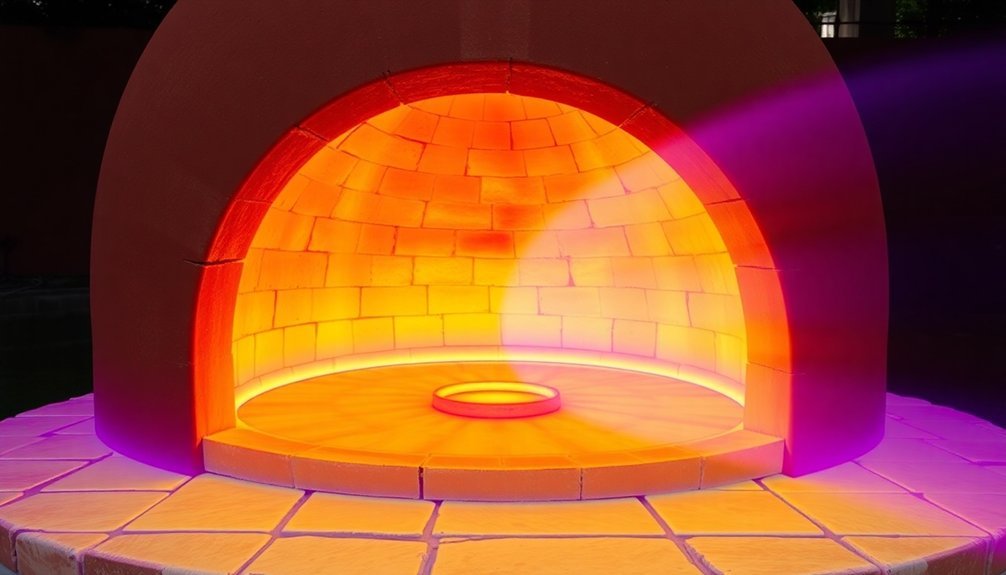

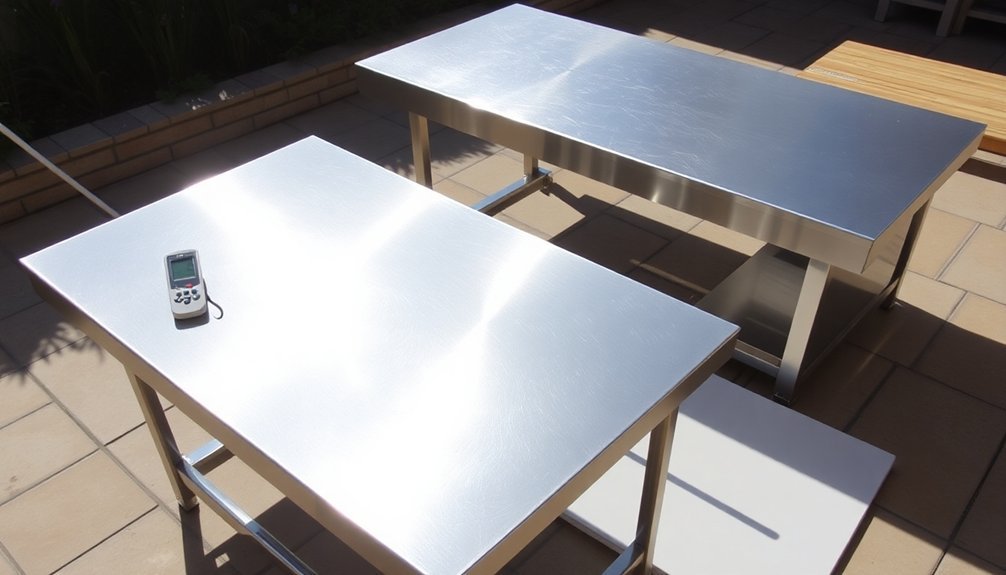
Leave a Reply